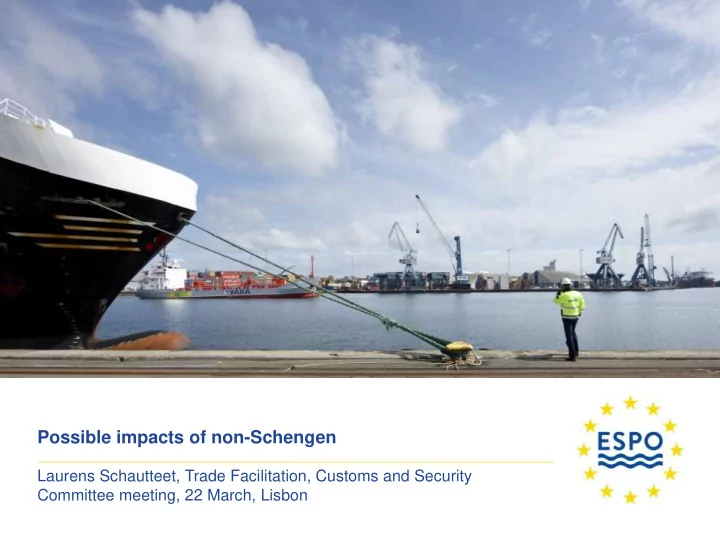

Possible impacts of non-Schengen Laurens Schautteet, Trade Facilitation, Customs and Security Committee meeting, 22 March, Lisbon
Table of contents 1. Schengen Area 2. Refugee crisis impact on Schengen 3. Cost of non-Schengen to the EU 4. Impact of non-Schengen to transport
1. Schengen Area o Schengen-Agreement • In effect since 1995 • 26 EU and EFTA Member States • Abolishment of passport and any other types of border control at common borders, also referred to as internal borders • Common visa policy
2. Refugee crisis impact on Schengen
2. Refugee crisis impact on Schengen o Different EU Member States have introduced temorary internal border controls because of the high migratory pressures at EU external borders o Border controls are legally based on extraordinary mechanisms foreseen in the Schengen Code: - Art. 23: up to 30 days, possible extension to 6 months - Art. 25: up to 10 days, possible extension in 20 days periods up to 2 months - Art. 26: up to 6 months, possible extension up to 2 years o Overall, eight countries reintroduced border controls (Belgium, Denmark, Germany, Hungary, Austria, Slovenia, Sweden and Norway) -> all eight cases made use of art. 25 and, because the situation did not improve, prolonged it on the basis of art. 23
2. Refugee crisis impact on Schengen o Following the closing of certain borders over the last months, bottlenecks have arisen at several important border crossings, with waiting times of 45 min to 3 hours or more at the French-Spanish, Austrian-German, Austrian- Hungarian or Sweden Denmark border crossings o On 4 March, the Commission has come up with a roadmap of concrete steps needed to return order to the management of the EU’s external and internal borders o If the migratory pressures and serious deficiencies in external border control in Greece were to persist beyond 12 May, the Commission could present a proposal under art. 26 to the Council, making it possible for Member States to introduce temporary border controls up to 6 months with a possible extension up to 2 years
3. Costs of non-Schengen to the EU • Lately, a number of studies have been published estimating the possible costs of a collapse of the Schengen zone: - « Commission Communication from 10 Febr. 2016 » = cost for the EU economy of systematic border check between 5 to 18 billion euros a year, with the most likely estimate to be 7.1 billion euros a year - « Cost of non-Schengen: The impact of border controls within Schengen on the Single Market » (European Parliament ) = drop in Schengen zone’s GDP by 0.86% in 2025, representing a loss of more than 100 billion euros - « Departure from the Schengen Agreement » (Bertelsmann Stiftung) = between 2016 and 2025, losses for the EU as a whole would be likely to reach 470 billion euros and up to 1.4 trillion euros - «The economic cost of rolling back Schengen » (France Stratégie) = drop in Schengen zone’s GDP by 0.8% in 2025, which is equivalent to a loss of more than 100 billion euros
3. Costs of non-Schengen to the EU • Studies seem to converge in concluding, that a permanent reintroduction of border controls would have a negative impact on imports and exports between countries belonging to the Schengen area of 10% in the lowest estimate and up to 20% in the highest estimate
4. Impact of non-Schengen to transport o The studies deal with the impact of non-Schengen on the transport sector, but do not make reference to the impact on ports or the broader maritime transport sector, however some issues treated in the studies could potentially impact the ports o Road transport would suffer increased journey times, resulting in increasing costs if border controls were to be reinstated -> It is estimated that delays at borders would cost 50 to 60 euro per hour, per vehicle -> Just-in-time deliveries and decentralised production processes would become more difficult -> The European Parliament study states that a shift to rail could offer solution, but does not examine maritime alternatives such as short sea shipping
4. Impact of non-Schengen to transport o Simulations point to a large potential impact for the tourism industry between EUR 10 and 20 billion, or 0.07% - 0.14% of EU GDP, if the reestablishment of border controls is associated with a fragmentation of the EU’s common visa policy o For EU citizens, the effective loss of time that would arise crossing through border controls is expected to at least lead to a decline in short trips and day visits -> possible impact to the ferry business in ports • Non-Schengen would also mean the abolition of the Schengen Visa = a Schengen visa from one country allows citizens from third countries to visit all of the other Schengen countries within a certain period of time -> possible impact to the cruise business in ports
European ports work!
Recommend
More recommend